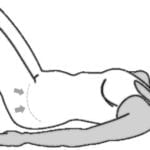Lauren Hasquet, PT, DPT
Spooner Physical Therapy Desert Ridge
20950 N. Tatum Blvd.
Suite 100
Phoenix, AZ 85050
480.502.5510
Do you ever feel like you are the only one that sneezes, coughs, or laughs and experiences a bit of urinary leakage? Even worse, do you feel uncomfortable bringing up the subject to your doctor or OBGYN? You are not alone! Urinary leakage or urinary incontinence, as it is more commonly referred to in the medical community, is an extremely common ailment that many women experience during their pregnancies, post-pregnancy, and even years later. The good news though is that urinary incontinence has a cure rate of 80%!
As you go throughout the course of your pregnancy you will find that your body will go through a number of changes from the mental to the emotional to the physical, the latter of the three being one of the biggest parts of your pregnancy that you can take control of, especially in your pelvic floor muscle groups. Stress can become more localized in this area and can cause incontinence due to pelvic floor dysfunction, resulting in urinary incontinence, bowel incontinence, or even organ prolapse.
As your baby continues to grow, their increasing weight will start to push on your bladder, resulting in more frequent trips to the restroom and pain and/or leaking when coughing, sneezing, and walking; however, our baby’s weight in not the only cause for these symptoms. During your baby’s development and your body’s preparation for childbirth, the connective tissue between your belly and pelvic floor muscles becomes more flexible, allowing your belly to grow; with this change, your pelvic floor muscles will adapt to support your baby’s passage through the birthing canal. Unfortunately, this change to your pelvic floor muscles also makes it easier for pelvic floor dysfunction issues to develop. Strengthening those pelvic floor muscles before, during, and after your pregnancy will not only help keep pelvic floor dysfunction at bay but will also help decrease the amount of pain that you will experience during and after your pregnancy.
Take on these negative side effects of your pregnancy with pelvic floor exercises that you can do in order to help, not only your pelvic floor, but also your hip, spine, and low back.
Kegels
This exercise is great for really targeting and strengthening your pelvic floor muscles.
Perform this exercise while lying down, sitting, or standing.
How to: As you are sitting at your desk at work, a red light on the road, or even at home watching your favorite show, you will being doing your kegels by squeezing/lifting your pelvic floor muscles up toward your heart, holding for ten seconds, and then releasing. Repeat 10 times. Those muscles that you are contracting are the same ones you use in order to stop urination when you are going to the bathroom, and that action of actively contracting your kegels will help strengthen all of your muscles in that area and make incontinence a thing of the past.
We recommend doing 3 sets of those 10 reps each day in order to strengthen and keep those pelvic floor muscles strong.
Bridges
This exercise is great for those experiencing lower back pain or a weak pelvic floor.
Perform this exercise lying down with your knees bent.
How to: As you lay on your back with your knees bent, you will lift your hips to the ceiling, hold for one second, and then bring them back down again, doing 3 sets of 10 repetitions. Gradually move through this exercise and don’t rush in order to really work those muscles. Want to make it a bit harder? Squeeze a pillow between your knees or wrap an elastic loop around your knees and keep your knees spread apart.
Different variations of this exercise that you can do also include:
• Straight Pulses: Hold your hips up and pulse them to the ceiling 10 times and relax. Repeat 10 times.
• Side-to-Side: Hold your hips up and move them like Shakira from side to side 10 times, 5 on each side. Make sure to move slowly in order to stabilize your shoulders and keep your torso strong.
• Rock the Boat: Hold your hips up and make like a belly dancer, dropping one hip toward the floor while pushing the other toward the ceiling. Alternate 10 times, 5 on each side.
Posterior Pelvic Tilt
(Transverse Abdominus)
This exercise can help with low back pain during pregnancy and also assists post-partum moms with diastasis recti or separation of the right and left rectus abdominis muscles.
Perform this exercise lying down or while standing against a flat surface.
How to: Think of a belly dancer while you do this exercise! You’ll want to start by tilting the front of your pelvis forward and up toward your chest and then back down again. Be sure to pull your belly button toward your spine, keeping your abs contracted inward to get a nice C shape in your spine and belly. Perform 3 sets of 10 repetitions. Add a kegel while you tilt your pelvis to really target your core and pelvic floor at the same time.
We recommend these exercises, not only for pre-natal, expecting, and post-partum mothers, but also for any woman that has been experiencing urinary incontinence. Minutes after delivery, you can perform your Kegels and Posterior Pelvic Tilts in order to bring more blood flow to your belly and pelvic floor muscles for improved healing and tightening. We know you will be exhausted and maybe just a little too enamored with your little bundle of joy to even consider doing these exercises but we highly recommend doing them when you can after delivery in order to help the overall healing process that your body will be going through and return strength to your pelvic floor muscles. After delivery, refrain from preforming Bridges until you have been cleared from your OBGYN for pelvic rest.*
Your local women’s health physical therapist acts as an excellent resource for any challenges you may encounter during your pregnancy or post-partum. They can also develop a pelvic floor program that it most ideal for you to maintain or return you to your ideal activity level during your pregnancy.
Be sure to check out our women’s health physical therapists at Spooner Physical Therapy at www.SpoonerPhysicalTherapy.com!
* – Note that no pain is normal after you have been cleared from pelvic rest. Your local women’s health physical therapist will be an excellent resource for any challenges you encounter during this exciting period of time.
Christie, Christina M. Female Chain Reaction. Gary Gray. October 30, 2013.
Non-Surgical Treatments for Female Stress Urinary Incontinence. National Associated for Continence. 2011. Available at: http://www.nafc.org/bladder-health/types-of-incontinence/stress-incontinence/non-surgical-treatment-for-female-stress-urinary-incontinence/. Accessed September 12, 2014.









